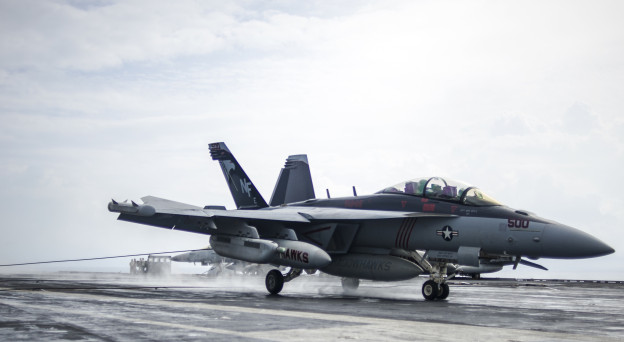
A senior member of the House Armed Services Committee is imploring the Pentagon to preserve the Boeing F/A-18E/F Super Hornet production line until the Lockheed Martin F-35C Lightning II Joint Strike Fighter has completed its development cycle.
“With future carrier-based aircraft still in development until 2019, I strongly believe that creating a single U.S. tactical aircraft supply chain at this time is too great a risk,” Rep. Randy Forbes (R-Va.), chairman of the House Armed Services Seapower and Projection Forces Subcommittee, wrote in a Dec. 4 letter addressed to Defense Secretary Chuck Hagel. “The loss of industrial capacity provided by the F/A-18 manufacturing line will eliminate vital competition that could result in spiraling costs, leading to more expensive, less capable systems.”
Forbes further noted that not only will the Navy be left with a sole-source for tactical fighters—since only Lockheed’s F-35 would remain in production after 2016—but there would be reduced competition for subsystems manufacturers.
“This budget decision would also eliminate competition among aircraft radar and engine producers,” Forbes wrote.
The President’s fiscal year 2014 budget proposal is expected to be the last with funding included to buy further lots of Super Hornets. The Navy had released a pre-solicitation for a further production lot in fiscal year 2015 in October, but quickly rescinded it a few days later saying that there was no requirement for more F/A-18E/F or EA-18Gs Growlers.
Noting that the Pentagon has intervened in previous years to preserve the ship and submarine industrial bases, Forbes suggested the Defense Department do the same for tactical fighter manufacturing.
“In other instances, the Department has taken steps to appropriately ensure multiple manufacturers in the shipbuilding and submarine industries,” Forbes wrote. “The Navy and the Department should nurture its tactical aviation manufacturing in the same way.”
Further, new innovations for next-generation fighters could be limited if the number of competitors dwindles—currently only Lockheed, Boeing and Northrop Grumman are capable of developing new combat aircraft from a clean-sheet of paper. Moreover, there are some industry analysts who doubt Northrop’s current capabilities to develop new aircraft by itself.
“Looking forward, investment in innovative technology and engineering for next-generation programs will be limited without a diverse tactical aviation base investing in tomorrow’s capabilities,” Forbes wrote. “A sole-source supply chain would be challenged to cope with changing demand, provide best-value capability, and reliability manage operational and readiness risks.”
The Navy is currently studying the requirements for the F/A-XX, a prospective replacement for the Super Hornet in the 2030s. However, given the Pentagon’s budgetary situation, the aircraft may not end up being what many might expect for a follow-on fighter.





